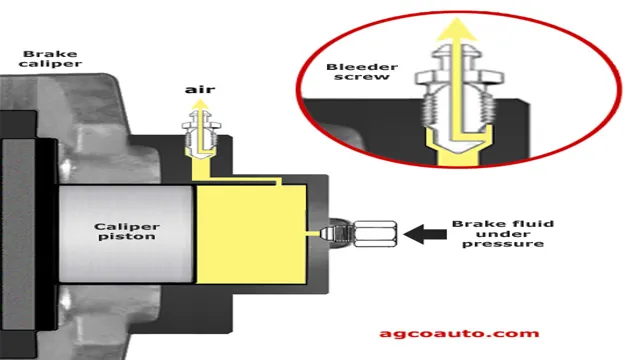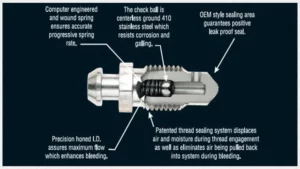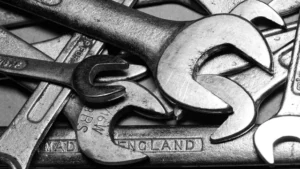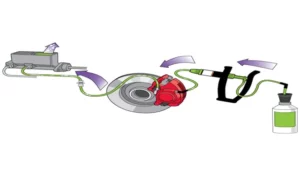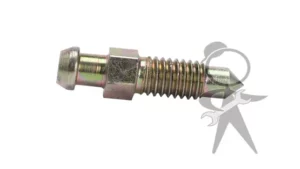If you are a car owner, you know that brakes play a crucial role in the safety of your vehicle. While a brake pad replacement may be the first solution that comes to mind when experiencing brake problems, there may be more to the issue. An important component of your vehicle’s brake system is the brake bleeder screw.
But what exactly is it, and why is it so important? Understanding the purpose of the brake bleeder screw can help you identify and troubleshoot any brake-related problems in your car. In this blog, we will dive deeper into the world of brake bleeder screws, discuss their uses, and provide tips on how to maintain them effectively.
What is a Brake Bleeder Screw?
If you’re wondering how a brake bleeder screw works, I’m here to help. This small screw is an essential part of the brake system, used to remove air bubbles from the brake lines to improve performance and safety. Air bubbles can accumulate in the brake lines over time, causing the brakes to feel spongy and less responsive.
The bleeder screw is located at each wheel cylinder and caliper and can be opened to release the trapped air. To do this, a specialized tool is used to connect to the screw and open it while someone pumps the brake pedal to expel the air. It’s a relatively simple process that can take just a few minutes to complete, but it can make a big difference in the way your brakes perform.
If you’re experiencing any braking issues, it’s worth checking the bleeder screws to make sure they’re not the culprit.
Definition and Functionality
A brake bleeder screw is a small valve located at each wheel of a vehicle’s braking system. Its primary function is to remove air bubbles or excess fluid from the brake lines, ensuring that the brakes operate effectively. It typically has a tiny hole that can be opened using a specialized wrench, allowing brake fluid to be released during the bleeding process.
When air bubbles or contaminated fluid buildup in the brake lines, it can reduce the effectiveness of the braking system, leading to accidents. Hence, proper maintenance involving checking and replacing the brake fluid and bleeding the brakes regularly is crucial for optimal safety. The Brake Bleeder Screw is essential in ensuring the safe operation of your vehicle, making it an accessory that you shouldn’t overlook.
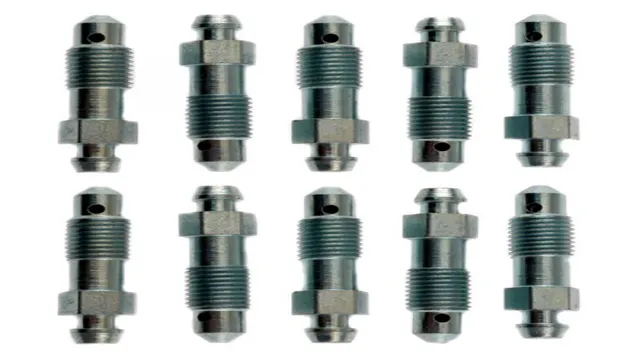
Types of Brake Bleeder Screws
A brake bleeder screw is a small valve located at the top of the brake caliper or wheel cylinder that serves as a release valve to remove air trapped inside the brake line. This may occur when the brake system is opened to replace or repair brake components. There are different types of brake bleeder screws, including screw-in and free-bleed.
A screw-in brake bleeder screw requires the use of a wrench to open and close it. This type of bleed screw is commonly used in calipers. A free-bleed brake bleeder screw is designed to be opened and closed by hand.
It is usually used in wheel cylinders and master cylinders. Knowing the type of brake bleeder screw you have is essential when repairing your own brakes. Using the wrong type of brake bleeder screw may damage the system and lead to brake failure.
Therefore, it’s always important to use the right brake bleeder screw for your vehicle and follow the manufacturer’s instructions.
How Does a Brake Bleeder Screw Work?
Are you curious about how a brake bleeder screw works? Well, it’s a small but essential part of your car’s brake system. The brake bleeder screw is located on each brake caliper, and its purpose is to release air and brake fluid from the system, ensuring that the brakes operate efficiently and safely. Without the brake bleeder screw, air bubbles would build up in the system, leading to brake fade and potential brake failure.
The brake bleeder screw is a small, threaded bolt that sits on top of the brake caliper. When the brake is pressed, hydraulic fluid is pushed through the brake lines and into the caliper. The pressure from this fluid allows the piston in the caliper to squeeze the brake pads onto the rotor, causing the car to slow down.
However, over time, air bubbles can build up in the brake system, which can cause a spongy or unresponsive brake pedal. This is where the brake bleeder screw comes in. By opening the screw, the mechanic can release the trapped air, ensuring that only fluid remains in the brake lines.
In conclusion, the brake bleeder screw may be small, but it plays a crucial role in keeping you safe on the road. If you notice any issues with your brakes or a spongy brake pedal, have a mechanic check your brake system, including the brake bleeder screw. Regular maintenance and servicing will help ensure that your brake system stays in top condition and that you can stop safely when you need to.
Step-by-Step Guide
If you’re wondering how a brake bleeder screw works, you’re not alone. It can seem like a bit of a mystery, but it’s actually a simple device that plays a crucial role in keeping your brakes functioning properly. Essentially, the bleeder screw is a small valve that allows air to escape from your brake lines.
When you press on the brake pedal, fluid is forced through the brake lines, but if there’s air trapped inside, it can interfere with your braking power. The bleeder screw ensures that any air in the lines can be released, allowing the brake fluid to do its job effectively. By opening the bleeder screw while also depressing the pedal, air is released, allowing for a better flow of fluid.
This is important maintenance and shouldn’t be taken lightly – if you neglect to bleed your brakes regularly, you may find yourself with weakened brakes that may prove to be dangerous on the road. Keep yourself and your passengers safe with regular brake maintenance!
Mechanism of Action
A brake bleeder screw is an essential component of the braking system that is responsible for releasing trapped air and allowing brake fluid to flow smoothly through the system. Essentially, it works like a tiny valve that is located at the highest point in the brake lines. When the brake pedal is pressed, the pressure created causes brake fluid to flow from the master cylinder to the brake caliper.
However, if air gets trapped in the brake lines, it can cause the brakes to feel spongy or unresponsive. This is where the brake bleeder screw comes in. It allows the mechanic to open up the brake system and release any trapped air by merely loosening the screw, allowing fluid and air to escape.
Once all the air has been removed, the screw is tightened back up, ensuring that brake fluid can flow smoothly through the system. This simple mechanism helps to ensure that your brakes always work correctly and keep you safe while driving on the road. So, it is essential to make sure your brake bleeder screw is in good condition and functioning correctly.
Why Bleed Brakes?
A brake bleeder screw is a small, but essential component of the braking system. It is usually found at the top of the brake caliper and is used to remove air and old brake fluid from the system during the braking maintenance process. Air bubbles can develop in the brake lines over time, which can lead to a spongy feeling when pressing on the brake pedal, reducing the overall effectiveness of the brake system.
This is where the brake bleeder screw comes in, allowing technicians to remove air and replace it with fresh, new brake fluid, ultimately improving the overall performance and safety of the braking system. Next time you are in for a brake service, it is important to ask your mechanic to check the brake bleeder screw to ensure optimal performance of your vehicle’s braking system.
Tools for Bleeding Brakes
When it comes to bleeding your brakes, having the right tools is essential. One such tool is the brake bleeder screw. This small screw is located near the top of each brake caliper and plays a vital role in the brake bleeding process.
The screw is used to release trapped air from the brake system, which can cause spongy brakes and affect stopping power. When you open the bleeder screw, it allows air and brake fluid to escape, creating a vacuum that draws fresh brake fluid into the system. This process is repeated until all the air is removed, leaving only clean brake fluid in the system.
It’s a simple concept, but one that requires careful attention to detail to ensure a successful bleed. So if you’re planning to bleed your brakes, don’t forget to include the brake bleeder screw in your toolkit!
Essential Tools
When it comes to maintaining your car’s braking system, bleeding the brakes is an essential task that cannot be ignored. To do it correctly, you would need the right tools for the job. One primary tool required for bleeding brakes is a brake bleeding kit.
This tool comprises a container with a hose that extracts old brake fluid from the brake lines and pedals. Another tool needed is a wrench to loosen and tighten the brake bleeder valve, which allows the air to escape from the brake lines. Additionally, a brake bleeder adapter is necessary to fit into the valve and specific brake fluid that matches your vehicle’s manufacturer’s requirements.
Having all these tools ready before starting the process makes brake bleeding more manageable and more efficient. By using the appropriate tools, bleeding brakes can be a straightforward task to complete, ensuring your car’s braking system operates optimally, preventing any accidents on the road.
Alternative Methods
If you’re looking for alternative methods to bleeding your brakes, there are a few tools that can help make the job easier and more efficient. One option is a one-way bleeder valve, which allows you to quickly and easily bleed your brakes without having to pump the brake pedal repeatedly. Another tool to consider is a vacuum bleeder kit, which uses suction to remove air from the brake lines.
This method can be especially useful if you have a lot of air in the system or if you’re working alone. A pressure bleeder is another option, which uses air pressure to force brake fluid through the system. Whichever method you choose, it’s important to follow the proper procedures and safety precautions to avoid damage to your brakes or injury to yourself.
By investing in the right tools and taking the time to do the job properly, you can ensure that your brakes are working safely and effectively.
Conclusion and Safety Measures
In a world where physics reigns supreme, the brake bleeder screw is the unsung hero that ensures the safety of drivers everywhere. Its simple yet effective design allows for the release of air and fluid from the brake system, ultimately preventing dreaded brake fade and providing maximum stopping power. So next time you hit the brakes, take a moment to thank the little screw that made it all possible.
It’s not just a screw, it’s a brake-savior!”
FAQs
What is a brake bleeder screw?
A brake bleeder screw is a small valve located on the brake caliper or wheel cylinder that allows the release of air or old brake fluid from the brake system.
How does a brake bleeder screw work?
A brake bleeder screw works by opening the valve and allowing the air or brake fluid to be released from the brake system. This helps to prevent air pockets from forming in the system, which can affect brake performance.
Why is it important to bleed brakes?
It is important to bleed brakes because air can get trapped in the brake lines, which can reduce brake performance and cause safety issues. Bleeding the brakes will remove any air and old brake fluid from the system, ensuring that the brakes work properly.
How often should I bleed my brakes?
Brake bleeding frequency can vary depending on the vehicle and driving conditions. It is recommended to bleed the brakes every 2-3 years or when performing brake system maintenance.
Can I bleed my brakes myself?
Yes, it is possible to bleed your brakes yourself with the proper tools and knowledge. However, it is important to follow proper safety procedures and consult your vehicle’s manual for specific instructions.
What tools do I need to bleed my brakes?
To bleed your brakes, you will need a brake bleeder wrench, a bleeder bottle or hose, and fresh brake fluid. You may also need a friend to help with the bleeding process.
What are the signs that my brakes need to be bled?
Signs that your brakes may need to be bled include a spongy or soft brake pedal, decreased brake performance, or a brake pedal that goes all the way to the floor. If you notice any of these signs, it may be time to bleed your brakes.
